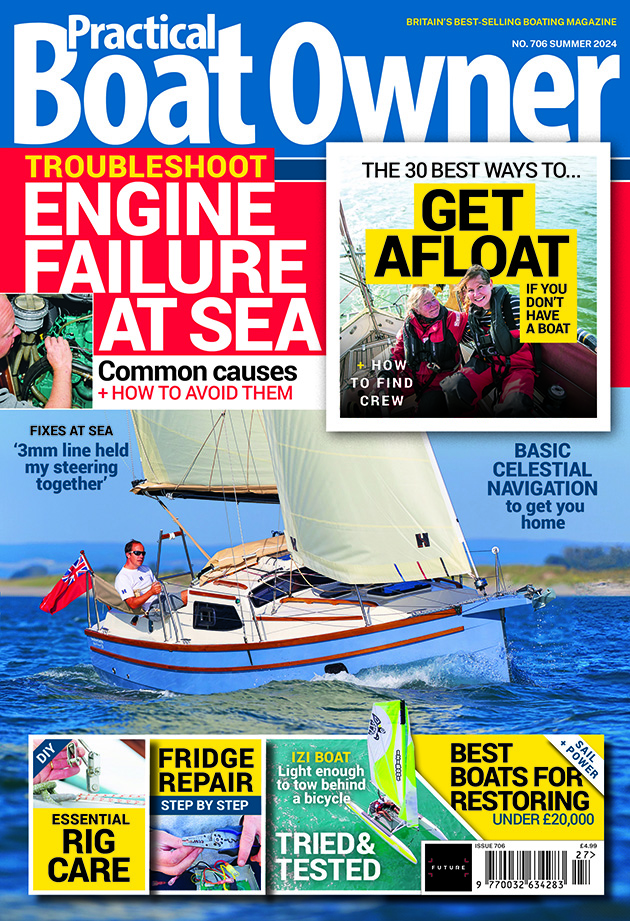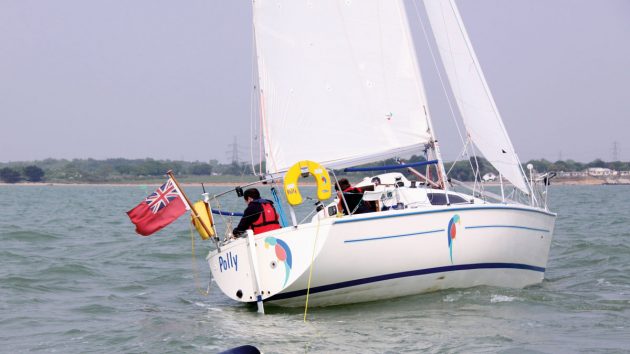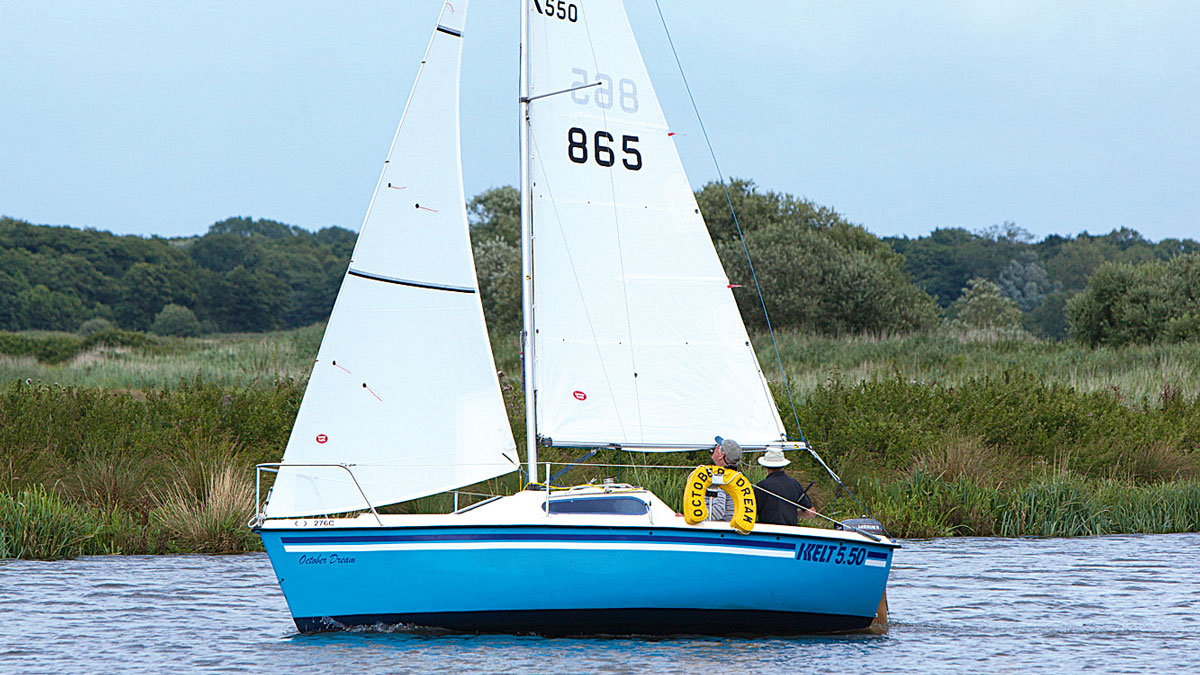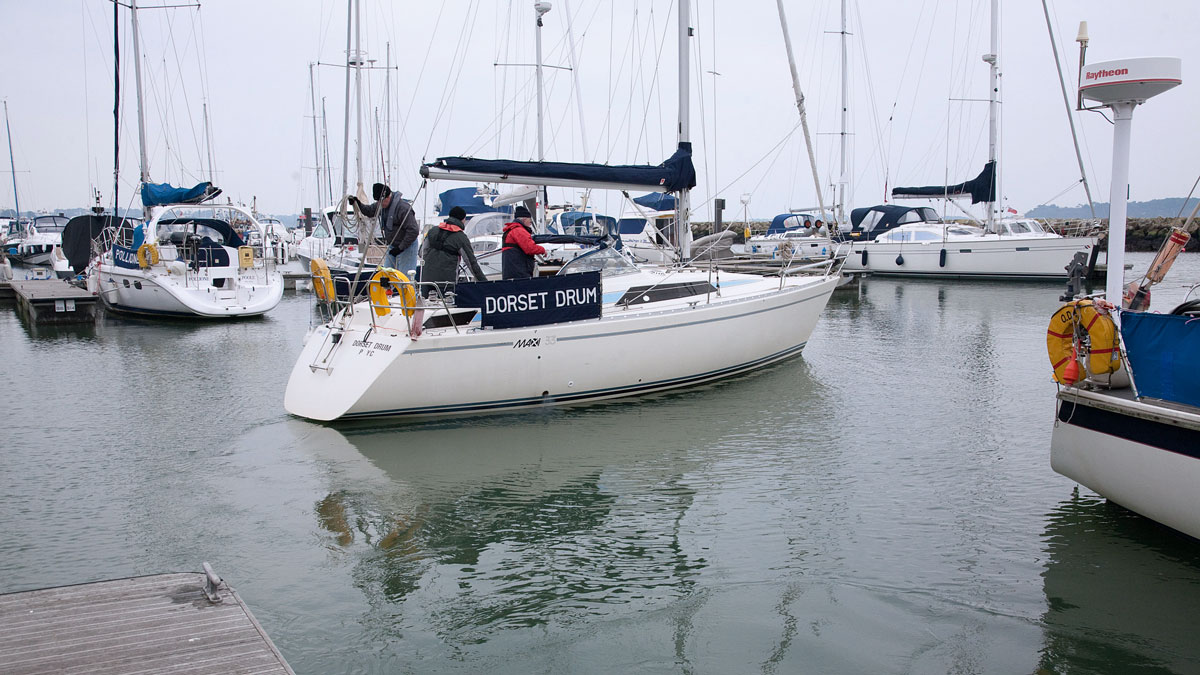How tricky is heaving to, and how much does it vary from boat to boat? We tried four different hull designs to find out. David Pugh reports
Countless magazine articles have been written about heaving to, but how many times do you actually see the manoeuvre carried out?
Not often for sure.
Yet those few sailors that do it on a regular basis swear by it as an essential seamanship skill.
So why is it so infrequently seen?

Hove to, the boat should fore-reach gently. Credit: Richard Langdon
One reason could be that it’s not as easy as it looks – perhaps the glib catechism ‘simply tack, then lash the helm to leeward’ is oversimplistic and, in practice, sailors have found it’s more trouble than it’s worth.
Or maybe it’s seen just as a way to ride out a storm.
But perhaps it really is a neglected technique that can provide valuable thinking time in the helter-skelter of a passage under sail.
Heaving to in practice
To find out, we took two boats, a Hunter Channel 245 and a Hunter Impala out on the water to see how tricky heaving to really is.
We followed up by trying the same techniques a Contessa 26 and a Beneteau Oceanis 40, which helped give us an idea of how transferable these techniques are to larger, modern yachts.
We have tried heaving to before, but neither could claim to be expert – like many sailors, we knew the theory but rarely used it.
However, I had already experienced a situation where the technique proved invaluable, and was keen to revisit it and perfect the method.

Stopping for a quick cuppa is just one reason to heave to. Credit: Eddie Mays
The time in question was in 2005, when my brother and I had planned a non-stop passage from Burnhamon-Crouch to deliver a Contessa 26 to her new berth in Poole.
Non-stop proved a bit ambitious – as we were off Newhaven, the tide turned against us and a steep sea built up that slowed our progress to a demoralising fraction of a knot, even with the assistance of the engine. Which then cut out.
The problem was a familiar one – in rough seas, when the fuel drops more than about three-quarters of the way down the yacht’s tank, the dip pipe will suck air and stop the engine.

The four boats: bilge keel – Hunter Channel 245. Credit: David Harding
Fixing it is a simple matter of topping up the tank, and as we always carry a spare 10lt can of diesel this was the obvious course of action – but with the boat corkscrewing in the waves it was going to be a tricky operation.
So we hove to.
It was our first attempt at the manoeuvre and she lay a little too far off the wind, but the effect was still magical – the yacht gently rode the seas at a consistent heel, water stopped splashing on board and filling the tank was a doddle.

The four boats: deep fin keel – Hunter Impala. Credit: Eddie Mays
We screwed the cap down firmly, restarted the engine and altered course for Brighton and a good night’s sleep.
Since then, we’ve used the technique from time to time whenever we’ve wanted to stop briefly with the minimum of fuss, but never really experimented to perfect our method.
Getting it right
Heaving to is essentially a balancing act – with the main driving forwards, the headsail backed and the tiller lashed to leeward, you try to achieve a balance which sets the boat at an angle which, were you sailing, would be around a close reach.
The theory is that the main will ‘weathercock’ the boat, making her point into the wind, while the backed jib keeps the bow off the wind.
The helm is used to balance the two and will usually be lashed to leeward, although some boats may heave to with the helm amidships or even slightly to windward.

The four boats: long keel – Contessa 26. Credit: Richard Langdon
Done well, the boat will probably fore-reach slightly, moving forward gently and helping to offset her own leeway.
Of course, nothing’s that simple and all boats heave to differently.
The Contessa 26 has a long keel and a typical masthead rig for her era with an overlapping headsail and small main.
Hove to under full sail, she will sit almost on a reach and tends to make considerable leeway – adequate for a very short stop, but self-defeating if you’re
trying to get to windward.

The four boats: fin keel – Dufour 40 Credit: Richard Langdon
By contrast a Hunter Impala, with a more modern mainsail-biased rig and fin keel, tended to round up and sit too close to the wind to be sure that she wouldn’t tack.
With all four boats, we started sailing under full sail before putting them into a tack and allowing the headsail to back before putting the helm fully down to leeward.
Heaving to: Bilge keel
Hunter Channel 245: LOA 8m/26ft

Reduced headsail allowed Aspire To to heave to tidily, but leeway was considerable Credit: Eddie Mays
With a 10-knot breeze, this bilge-keeled cruiser responded best to gentle handling, so we put her through a long, slow tack.
As the headsail backed we gradually pushed the tiller to leeward to stop the turn.
She settled contentedly about 70° off the wind, but leeway was considerable.
Reducing the headsail to just within the foretriangle brought her around 10° closer to the wind and reduced the leeway.

Smaller headsails also set neatly – much bigger than this and it would hang up on the shrouds
However, the grip of the bilge keels still wasn’t enough to allow us to hold station and we continued to slide downwind at around half a knot.
Making the headsail even smaller brought her too close to the wind and left her in danger of tacking – we needed to reef the main to balance her.
Changing the rudder position affected the boat’s angle to the wind, but was not enough to start a gybe without easing the mainsail.
We tried exiting the manoeuvre by tacking the headsail and also by gybing the boat. Both worked, but tacking the headsail proved more effective in this case, as the gybe was very slow.
Heaving to: Deep fin keel
Hunter Impala: LOA 8.5m/28ft

The Impala hove to easily, once we had learned to fi rst take the way off her. Credit: Eddie Mays
In contrast to the Hunter Channel, the Impala is an extremely responsive hull design that will tack and power up rapidly.
Simply tacking and allowing the jib to back didn’t work – the Hunter Impala retained too much drive in her main and would pass back through the wind to her original tack if the helm was put to leeward, or continue through a gybe with the helm to windward.
The trick proved to be to deliberately stall the boat during the tack, pausing as the bow passed through the wind in order to reduce the boat speed.

With her No4 headsail, the Impala hove to best with a reef in her mainsail
We were sailing with the No4 headsail, and with this backed and the main sheeted hard in she hove to between 40° and 50° off the wind.
However, small gusts would cause her to round up and sometimes tack, even when we brought the helm up slightly, so we found that it was best to ease the mainsail until she sat at around 60°. Reefing the main had the same effect while eliminating occasional flogging, and leeway was minimal.
When we wanted to start sailing again, the Hunter Impala would rapidly pick up speed whether we chose to tack the headsail or gybe.
Heaving to: Long keel
Contessa 26: LOA 8m/26ft

The Contessa 26 heaves to comfortably and fore-reaches gently with a small headsail. Credit: Richard Langdon
The conditions when we tried this were marginal for full sail, with the breeze gusting to around 18 knots.
Long keels are reluctant to do anything too quickly, so first of all we hove the Contessa 26 to with a long tack.
She settled down well enough, but at around 80° to the wind was nearly broadside to the swell.
Interestingly, reducing headsail initially caused us to fall further off the wind, and it wasn’t until the sail was reduced sufficiently to bring the headsail well within the foretriangle that she came up to our target 60° from the wind, proving that the headsail overlap provides a significant turning moment towards the wind.

Too much headsail leaves the Contessa 26 sitting nearly broadside to the wind. Credit: Richard Langdon
At this point, she was well-mannered and took the seas gently just off the bow with no sign of rounding up or falling off significantly in either direction.
Leeway was apparent but minor.
Exiting the hove-to position, the reduced headsail made it fairly simple to sheet the headsail to the opposite side, or by moving the helm to windward she would gently gather way and gybe.
Heaving to: Fin Keel
Beneteau Oceanis 40 LOA 12m/40ft

The Dufour 40 hove to comfortably enough, but with topsides this high you can expect to make leeway Credit: Richard Langdon
Although a modern boat, the Beneteau Oceanis 40’s rig is quite traditional with a large headsail, which needed significant reduction before she would balance at the required angle.
Once there, she sat contentedly at 60° but made considerable leeway owing to her high topsides and relatively shallow draught compared to her windage – we judged it at nearly half a knot.

Balancing the headsail is essential – we went too far here and nearly tacked the boat. Credit: Richard Langdon
Leaving the hove-to position worked perfectly whether the sail was tacked or the vessel gybed, but with such a large boat the gybing option is considerably more popular with the crew!
Continues below…
The changes I made to my boat to get it to tack properly
Following a second visit to a Kelt 550 suffering from upwind reluctance, David Harding outlines the changes made to the…
Berthing a boat using wind and tide
Manoeuvring a boat into and out of a berth is one of the most frequent handling challenges facing boat owners…
Berthing a vessel: 2 clever ways with warps
In these days of fin keels, bow-thrusters and powerful engines, using warps for marina manoeuvres might seem an old-fashioned irrelevance…
Boat hull design: how it impacts performance
Peter Poland explains how boat hull design has evolved over the years and how it affects boat handling and accommodation
Heaving to: the essentials
Roller reefing
- For heaving to in moderate conditions, roller reefing is a real asset. The facility to adjust the amount of pressure exerted in the foretriangle makes the manoeuvre much easier to balance, and deploying a smaller headsail reduces heel when hove to and makes life more comfortable.
Hank-on sails
- All but one of the boats we tried needed the headsail to be reduced, with the exception of the Hunter Impala where we had already chosen a smaller headsail. If you have hank-on headsails or a headfoil and plan to heave to for a prolonged period you may need to change to a smaller sail than the ideal for the conditions, but for short periods any method of depowering the foretriangle area will do – easing the windward sheet or moving the sheet lead aft, for instance.
Adjusting the main
- If, as in the case with the Hunter Impala, the mainsail is exerting too much force and bringing you too close to the wind, you have the option of reefing or easing the main, or bringing up the helm slightly. We found the boat was more stable with the helm fully to leeward and the sail adjusted.
Give it a go!
- What works for individual boats is best established by informed trial and error – start off with the conventional methods and tweak them to suit. A prime example was the Hunter Impala’s need to have her way taken off before she would heave to effectively. Without doing so, she would either tack or pay off rapidly according to the position of the rudder.
Tack or haul?
- Without exception, we found that the easiest way to heave to was to tack without adjusting the sheets – hauling the headsail across is hard work and bad for the sail unless it has no contact with the standing rigging. Tacking is also a very quick way to heave to – for example, in the case of a man overboard, you could stop almost instantly in order to get the sails down and motor back. Heaving to on starboard tack will retain your right of way.
Getting away
- With the long-keeled and bilge-keeled boats we found it easiest to tack the jib over to the same side as the main to sail away. The Beneteau would
probably get under way quicker this way as well, but the size of the sails and the amount of effort required to grind in the headsail make it easier and certainly more crew-friendly to gybe. With racier designs such as the Hunter Impala, gybing is almost as quick as the boat pays off quickly once the helm is brought to windward, with the narrow fin keel offering little resistance to the yacht’s turn.
Is it worth it?
- As a result of our experiments, I’ll certainly be heaving to more. It’s a very effective way to allow you to reef single-handed – I’ve discovered that the Contessa 26 will heave to quite happily under headsail alone with the helm fully to leeward, leaving you free to reef the main at leisure. I’ve yet to have to heave to in a storm, but from calmer conditions, I have much more confidence that it is a viable way to safely ride out rough seas, given an appropriately reduced sail plan. Even in calmer weather, it’s a simple way to flatten things out for a time if a crewmember is feeling queasy or you’re serving up food or hot drinks, and is well worth remembering.
Enjoy reading this article?

A subscription to Practical Boat Owner magazine costs around 40% less than the cover price.
Print and digital editions are available through Magazines Direct – where you can also find the latest deals.
PBO is packed with information to help you get the most from boat ownership – whether sail or power.
-
-
-
- Take your DIY skills to the next level with trusted advice on boat maintenance and repairs
- Impartial in-depth gear reviews
- Practical cruising tips for making the most of your time afloat
-
-
Follow us on Facebook, Instagram, TikTok and Twitter








